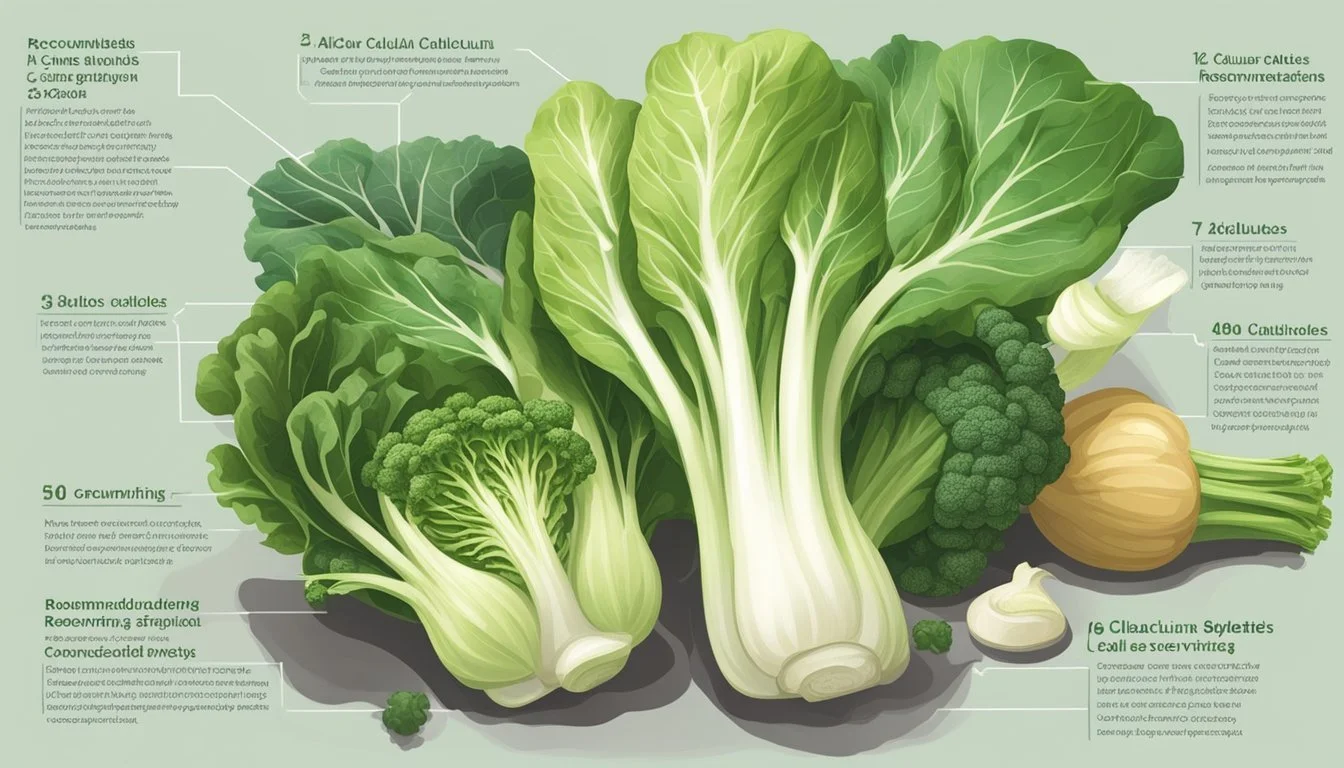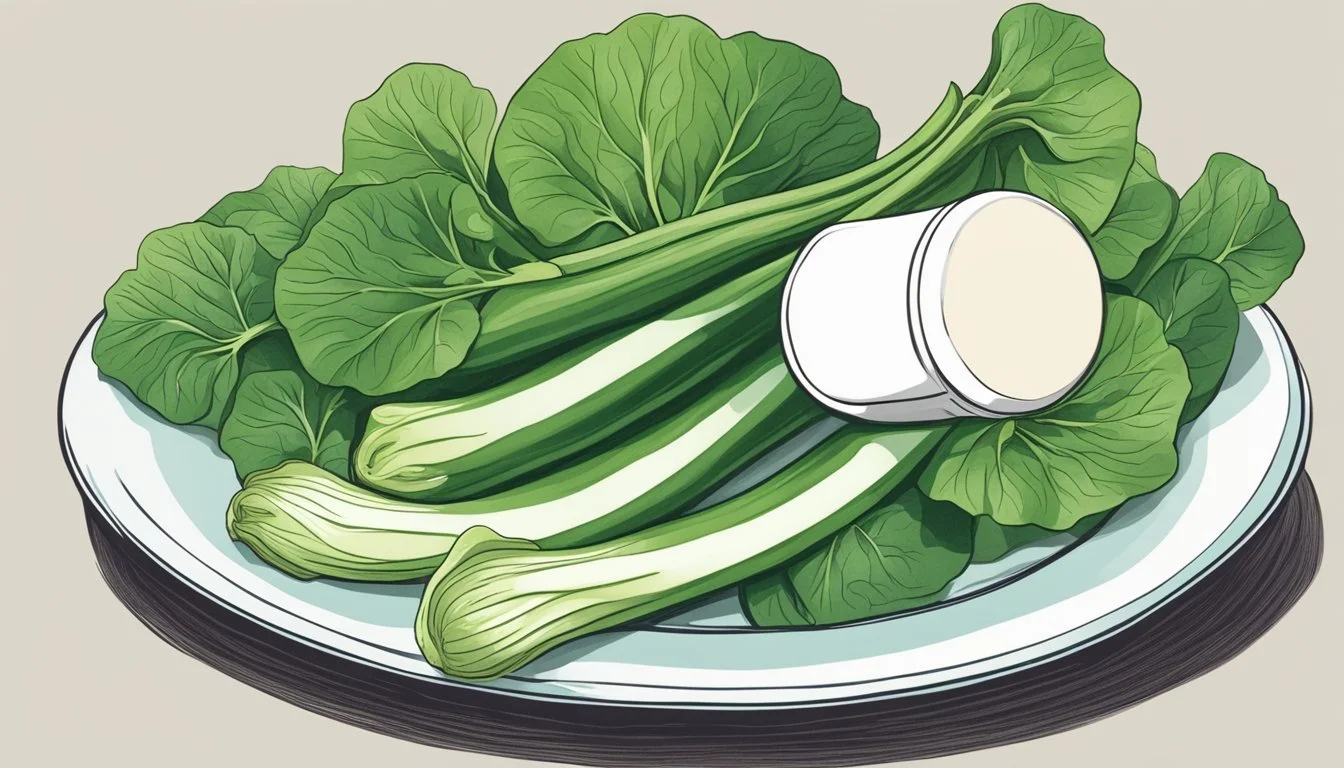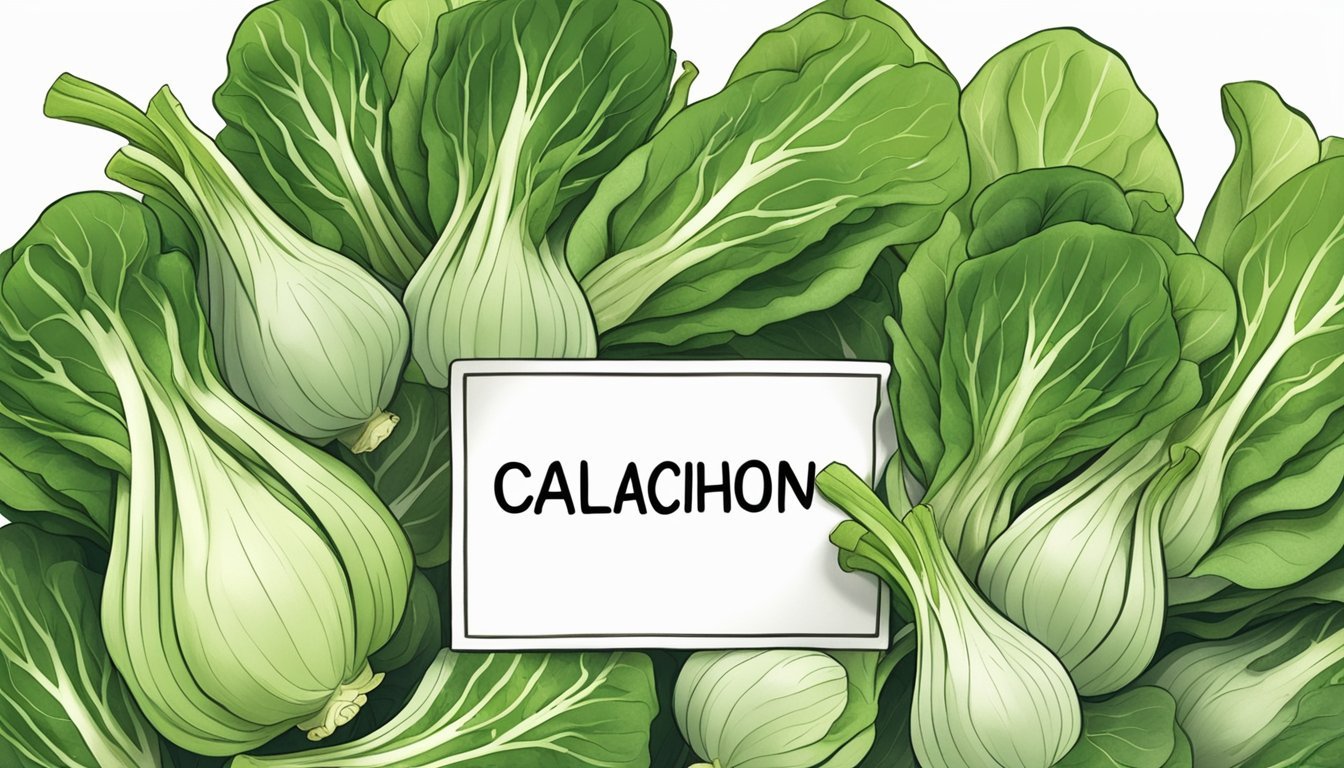How Many Servings of Bok Choy Provide Optimal Calcium Benefits?
Bok choy, a leafy green vegetable belonging to the cruciferous family, is often celebrated for its nutritional density and health benefits. It is particularly noted for its calcium content, an essential mineral crucial for bone health, muscle function, and nerve transmission. When considering the optimal intake of calcium through diet, it is essential to examine the contribution of various food sources including vegetables like bok choy. Understanding the calcium content per serving of this vegetable can guide individuals on how much to include in their diet to meet daily calcium requirements.
As a cruciferous vegetable, bok choy not only offers calcium but also a spectrum of vitamins and minerals that support overall health. Regular consumption of bok choy can be a great addition to a balanced diet due to its low calorie and high nutrient profile. The key is to determine how many servings of bok choy would contribute significantly to one's daily calcium intake without displacing other necessary foods that balance the diet. With each serving carrying a range of nutrients, individuals can benefit from integrating the right amount of bok choy into their meals to capitalize on its health-boosting properties.
Nutritional Profile of Bok Choy
Bok choy, known for its crisp leaves and succulent stalks, is a leafy green vegetable brimming with nutritional value. One cup of cooked bok choy is low in calories but dense with vital nutrients, making it an excellent addition to a balanced diet.
In terms of vitamins, this vegetable is a substantial source of vitamin A, with some sources citing as much as 144% of the Daily Value (DV). It also boasts an impressive vitamin C content, necessary for immune function and skin health, providing about 74% DV. Vitamin K is another significant component, crucial for blood clotting and bone health, at 72% DV per cup of cooked bok choy.
The mineral content of bok choy is equally noteworthy. It contains calcium, important for bone strength and dental health. Additionally, it supplies the body with iron, which is essential for oxygen transport, and magnesium, selenium, potassium, zinc, phosphorus, and manganese—all minerals that support various bodily functions.
When it comes to macronutrients, bok choy provides a modest amount of protein and fiber, both important for digestion and satiety. Carbohydrates in bok choy are primarily complex, with a low sugar content making it suitable for those monitoring their blood sugar levels. It is also almost completely devoid of fat.
Finally, bok choy is relatively low in sodium, which can help in maintaining a healthy blood pressure. Inclusion of folate makes it beneficial for cell growth and metabolism, rounding out its rich nutritional profile.
Health Benefits of Bok Choy
Bok Choy, a cruciferous vegetable, is an excellent source of nutrients with multiple health benefits, including supporting bone health, reducing blood pressure, combatting inflammation, and potentially lowering cancer risk.
Bone Health and Calcium Intake
Bok choy contributes to strong bones due to its high content of calcium, which is essential for maintaining bone density and strength. It also provides vitamin K, phosphorus, iron, and magnesium—all vital for bone formation. Regularly consuming bok choy can aid in meeting one's recommended daily intake of these minerals for bone health.
Cardiovascular Support and Blood Pressure
This leafy green is associated with heart health by aiding in the management of blood pressure. Elements such as potassium in bok choy help relax blood vessels, which reduces the risk of hypertension and subsequent heart disease. The presence of folate also contributes to cardiovascular support by managing homocysteine levels, high levels of which are linked to heart problems.
Cancer Prevention and Cruciferous Vegetable Intake
As a cruciferous vegetable, bok choy contains glucosinolates, which have been studied for their protective role against cancer. By including bok choy in one's diet, an individual may benefit from its potential to lower the risk of certain cancers owing to its role in cellular detoxification processes and antiproliferative effects.
Inflammatory Response and Anti-Oxidative Effects
The antioxidants found in bok choy, including vitamin C and selenium, are crucial for their anti-inflammatory properties and support of the immune system. They protect cells from damage, aid in collagen synthesis for skin and eye health, and may help regulate thyroid function. An adequate intake of these nutrients through bok choy can support the body's inflammatory response and immune system functioning.
Culinary Uses of Bok Choy
Bok choy, a leafy green vegetable, has gained popularity for its versatility in salads, stir-fries, and soups. Rich in nutrients, it is a staple in Asian cuisine and can be served as a nutritious side dish or incorporated into various recipes.
Bok Choy in Salads and Raw Preparations
Raw bok choy provides a refreshing crunch and slight peppery flavor to salads and slaws. To prepare:
Wash: Rinse leaves and stalks under cold water.
Trim: Remove any discolored leaves and trim the ends.
Slice: Cut into thin strips for a delicate texture in your salad mix.
Cooking with Bok Choy: Stir-Fry and Sauté
When stir-fried or sautéed, bok choy becomes tender yet retains a subtle crispness:
Prep: Chop into evenly sized pieces for consistent cooking.
Heat: Use a wok or skillet over medium-high, with high smoke point oil like avocado.
Stir: Constantly move the bok choy to cook evenly and prevent burning, about 3-4 minutes.
Soups and Broths: Incorporating Bok Choy
Soups and broths benefit from bok choy's verdant color and rich nutrients:
Chop: Cut leaves and stalks into bite-sized pieces.
Add: Introduce bok choy at the end of cooking to maintain its color, texture, and nutritional content.
Simmer: Let it cook just long enough to become tender but not overly wilted.
Comparison with Other Cruciferous Vegetables
Cruciferous vegetables are notable for their nutritional profiles, particularly their calcium content. This section examines how bok choy stands alongside its kin, such as broccoli, kale, and Brussels sprouts, in terms of nutritional composition and the unique benefits it offers.
Nutritional Differences Among Cruciferous Vegetables
Cruciferous vegetables are varied in their nutritional offerings, especially concerning calcium levels. Below is a comparison of calcium content in common cruciferous vegetables per one cup of raw servings:
Bok choy (pak choi): 74 mg
Broccoli: 43 mg
Kale: 101 mg
Brussels sprouts: 37 mg
Cabbage: 40 mg
While these vegetables share similar health benefits, such as being rich in vitamins and fiber, bok choy tends to offer a higher amount of calcium than cabbage and Brussels sprouts but is slightly lower than kale.
Unique Aspects of Bok Choy
Bok choy, also known as Chinese cabbage, offers a unique composition that sets it apart from other members of its family:
An excellent source of vitamin A, C, and K.
Delivers more vitamin A and vitamin C than spinach, serving as a powerful antioxidant source.
Provides a lower oxalate content, which can be beneficial for individuals with kidney stones or other health concerns where oxalate intake needs to be monitored that set it apart from some leafy greens like spinach.
Bok choy, due to its nutrient density and lower oxalate levels, may be a preferred cruciferous vegetable for individuals prioritizing calcium absorption.
Potential Risks and Interactions
Consuming bok choy contributes to a well-rounded diet, but there are certain conditions where its components may affect health due to interactions with medication or impact on thyroid function. Understanding these factors is crucial for individuals on blood thinners or those with thyroid concerns.
Interactions with Blood Thinners and Vitamin K
Bok choy is rich in vitamin K, which is essential for normal blood clotting. However, this same property can interact with blood thinners like warfarin, where consistent vitamin K intake is necessary to maintain the efficacy of the medication. Sudden changes in vitamin K consumption can either reduce the effectiveness of warfarin or increase the risk of blood clotting.
Recommended: Individuals on warfarin should monitor their vitamin K intake and keep it consistent to avoid interaction issues.
Effects on Thyroid Function and Iodine Absorption
Bok choy contains substances called glucosinolates, which, when broken down by the enzyme myrosinase, can yield isothiocyanate, affecting thyroid function. Isothiocyanates can compete with iodine absorption, a mineral crucial for thyroid health, potentially leading to hypothyroidism in susceptible individuals. Additionally, bok choy also contains selenium, which is necessary for thyroid hormone production but can be of concern if consumed in excessively high amounts.
Consideration: Individuals with thyroid conditions should be aware that consuming large quantities of bok choy may affect thyroid hormone synthesis and iodine uptake.
Action: Cooking bok choy may deactivate myrosinase, thereby reducing the formation of isothiocyanates and its potential impact on the thyroid.
Guidelines for Consumption
When considering how many servings of bok choy to include in a diet for calcium intake, it's essential to take into account the dietary recommendations set forth by organizations such as the USDA. Bok choy, a leafy green vegetable, is known for providing a variety of nutrients such as calcium.
A single serving size of bok choy is generally considered to be about one cup. Whether consumed raw or cooked, bok choy offers nutritional benefits, although cooking can slightly alter the nutrient profile.
To meet calcium needs, the recommended daily allowance (RDA) for adults according to USDA guidelines is 1,000 mg for most adults, while women over 50 and everyone over 70 should aim for 1,200 mg. In light of this, one can consider the following table of calcium content in bok choy:
State of Bok Choy Approximate Calcium Content per Cup Raw 74 mg Cooked 158 mg
Given that the calcium content for cooked bok choy is higher per cup, individuals may include more of this form if their primary concern is increasing calcium intake. With this in mind, a person would need to consume multiple servings of bok choy to approach the RDA for calcium. However, it is vital to achieve a balanced diet by incorporating a variety of calcium-rich foods alongside bok choy, to ensure that all nutritional needs are met with equal importance.
The Role of Bok Choy in Dietary Patterns
Bok choy, a leafy green member of the cruciferous vegetable family, stands out in dietary patterns due to its rich nutrient profile and versatility in cooking. Recognized for its low calorie content, bok choy is an attractive ingredient for those managing energy intake. A single serving of bok choy offers an appreciable amount of calcium, necessary for bone health and muscle function.
Nutrient Composition:
Fiber: Essential for digestive health and satiety.
Vitamins: Significant levels of Vitamin A, C, and K, and contains Vitamin E.
Minerals: Source of calcium and iron.
Incorporating bok choy into meals contributes to the daily intake of antioxidants, such as Vitamin C and Vitamin E, combating oxidative stress and supporting overall health. The vegetable’s fiber content promotes a healthy digestive system and can aid in regulating blood sugar levels due to the minimal presence of sugars.
Carbohydrates in bok choy are present in low amounts, making it suitable for low-carb diets. It is an ideal ingredient for a balanced meal, contributing essential nutrients without excessive calorie load.
Serving Suggestions:
Add to salads for a crunchy texture.
Stir-fry with other vegetables for a fiber-rich side dish.
Incorporate into soups or stews to enhance nutrient density.
When considering how bok choy fits within dietary patterns, one must acknowledge its role in providing essential nutrients while facilitating calorie control. It's a versatile vegetable that can be easily included in various culinary traditions, making it a valuable component of a balanced diet.
Agricultural and Market Information
Bok choy, also known as Chinese white cabbage, is a leafy green vegetable that is a staple in Asian cuisine. Characterized by its green leaves and white stems, bok choy presents a crisp texture that is smooth to the touch. The leaves are dark green and typically have a glossy appearance, which not only contributes to its visual appeal but also indicates freshness.
In China, bok choy has been cultivated for centuries and remains an integral part of traditional dishes. Owing to its popularity, bok choy production has spread to other parts of the world, including the United States. Within the U.S., growers have adopted bok choy into their crop rotation, capitalizing on its increasing demand in both local and national markets.
Production Regions:
China: Native region with extensive cultivation.
United States: Adapted production, mostly in states with favorable climates.
The market for bok choy has seen growth due to its health benefits and versatility in recipes. This vegetable has been successfully marketed as both a fresh and a cooked ingredient, suitable for various culinary applications.
When shopping for bok choy, consumers are advised to look for bunches with firm stalks and crisp leaves. Quality bok choy should be free from any signs of wilting or blemishes. The optimal freshness of bok choy influences its nutritional content, including its calcium levels, which are an important consideration for those looking to boost their calcium intake through vegetables.
To ensure sustainability and meet market demand, producers must handle bok choy with care, from cultivation to harvest, through to distribution. As the market for bok choy continues to develop, producers and retailers alike adapt to the shifting preferences, aligning their offerings with consumer expectations for quality and freshness.
Environmental Considerations and Farming Practices
When cultivating bok choy, organic farming practices play a significant role in environmental sustainability. Organic methods focus on soil health, eschewing synthetic pesticides and fertilizers in favor of natural alternatives. This approach fosters biodiversity and reduces chemical runoff, ultimately contributing to water and soil quality.
Sustainable farming encompasses more than just the absence of chemicals. It includes crop rotation, cover cropping, and the integration of livestock. These practices reduce the need for external inputs and increase the farm's resilience against pests and diseases.
The use of pesticides, while common in conventional bok choy farming, can be mitigated through integrated pest management (IPM). IPM strategies employ biological controls, habitat manipulation, and resistant varieties to keep pest populations in check while minimizing environmental impact.
Choosing local produce can also help reduce the carbon footprint associated with long-distance transportation. Consumers have the power to support local farmers who practice sustainable agriculture, thus promoting a healthier ecosystem.
Farming Practice Benefits Organic Farming Enhances soil health, reduces chemical runoff Sustainable Farming Promotes biodiversity, conserves resources Pesticide Management Lowers environmental risks Local Produce Cuts down on transportation emissions
Farming practices have a direct effect on the surrounding environment and the quality of produce consumers receive. By supporting practices that are both sustainable and environmentally conscious, individuals contribute towards a healthier planet.
Scientific Studies and Research
Recent research reveals that bok choy, a Brassica family member, contributes to bone health due to its calcium content. Studies indicate that a high intake of cruciferous vegetables like bok choy can be associated with a lower risk of chronic diseases, including certain types of cancer such as colon cancer.
Bone Health: Regular consumption of bok choy provides calcium, as crucial research articulates its role in maintaining optimal bone density and preventing osteoporosis. Calcium's benefits extend to bolstering heart health, although the exact number of beneficial servings has not been universally established.
Cancer Prevention: Bok choy contains sulfur-containing compounds, isothiocyanates, and quercetin, which show anti-cancer properties in various studies. These compounds may contribute to reducing the risk of cancer, including colon cancer. Analyses suggest that the inclusion of bok choy in the diet can be part of an anti-cancer nutritional plan, although serving size efficacy is variable.
Eye Health: It is also a source of lutein and zeaxanthin, carotenoids beneficial for eye health. While not directly related to calcium intake, these nutrients support the overall nutrient density of bok choy servings.
Heart Disease and Chronic Diseases: The vegetable includes nutrients like folate and choline that can help reduce homocysteine levels—a risk factor for heart disease. While the quantity of bok choy needed to reap these benefits remains unclear, their vital roles in preventing chronic and heart-related diseases are acknowledged.
In conclusion, while definitive serving recommendations are beyond the scope of current research, the cumulative findings endorse multiple servings of bok choy as beneficial for a holistic approach to health, particularly in calcium's role in bone maintenance and potential disease prevention.












